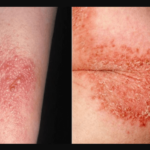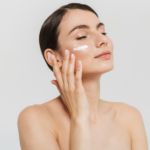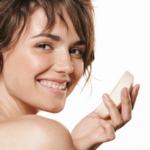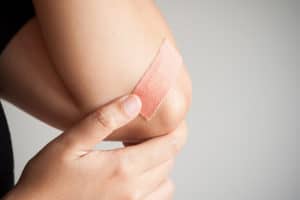Trump’s skin tone has been talked a lot about in the press, with it being matched with the Pantone shade of “gold flame.”
Why does Donald Trump’s skin have an orange tint? Four possible reasons for the orange hue are from:
- Tanning lotions and bronzers
- Suntan from Mar-a-Lago
- Rosacea
- He does his own hair and makeup
In this post, I’ll discuss each of these possible reasons for Trump’s orange hue and then discuss how to avoid your own orange face with common foundation mistakes.
Why Is Donald Trump So Orange?
1. Tanning Lotions and Bronzers
Trump is friends with tanning mogul Steve Hilbert. Steve Hilbert is CEO of New Sunshine, a line of tanning products including lotions and bronzers used by the Kardashians. Trump’s friendship with Hilbert allegedly began around 2006, which is around the time when Trump’s skin started to take on a more copper tone.
Trump even promoted two of Hilbert’s tanning products on Celebrity Apprentice in 2011 and in 2013. Also, in 2011, Melania Trump became the face of New Sunshine’s caviar-based skincare line for a reported 1 million dollars.
Some claims have been made that Trump enjoys using a tanning bed or that he has one in the White House, but there has been no proof of that. Most agree that his skin tone is more from a spray than a bed.
2. Sun Tan from Mar-a-Lago
To answer the common question of ‘why is Donald Trump orange’ could perhaps be solved by the most basic explanation of all: sunshine. Makeup artist Jason Kelly told Marie Claire that Trump might be absorbing UVA and UVB rays by soaking up the sun on the golf course.
He said in 2017, what I see now is not so much tanning bed or spray but maybe the sun that he’s getting. He might be getting a lot of that tan at Mar-a-Lago. And he may not be using enough sunscreen.
Whatever the case may be, stories about Trump’s skin just won’t quit. In February 2019, the New York Times actually published a piece titled In the Pale of Winter, which talked about Trump’s skin color. Trump’s tan remains a state secret as for his administration’s response, officials have allegedly credited good genes for that year-round glow.
3. Rosacea
Perhaps Donald Trump has altered his natural skin tone because he actually has troublesome skin underneath all of that color-coding. The president’s longtime physician, Dr. Harold N. Bornstein, claims Trump uses antibiotics to treat rosacea.
As the New York Times reported, rosacea is a fairly common skin condition whose symptoms include redness of the skin, eye problems, large pores, broken capillaries, dry patches, and a stinging or burning sensation.
If Trump’s skin is red and irritated from rosacea, it’s possible that cosmetics used to conceal it have the wrong undertone. It may look flawless upon application but turn orangey and unnatural as the day goes on, according to Marie Claire.
4. He Does His Own Hair and Makeup
It takes work to get what we’ve come to appreciate as the POTUS’s signature glow, and some reports suggest that he does that work himself. Chris Blevins was a makeup artist for every presidential candidate in the 2016 New Hampshire primaries except Donald Trump.
She said that she never saw Trump with a makeup artist or hairstylist. She added Donald Trump does his own hair and makeup, as well as maybe a little blotting powder.
He’s got his hair down to a science, he has a signature look, he carries with him that is his look, and that’s far better than changing it up all the time.
In January 2018, Politico reported that Trump did have a makeup artist on the federal payroll but that artists never spruced him up instead of focusing on members of his cabinet, including Sarah Huckabee Sanders and Kellyanne Conway.
Republican National Convention makeup artist Jason Kelly told Harper’s Bazaar (fashion magazine) that he believes ever since the campaign, Trump is using spray tans alleging Trump wears the goggles, and you can see the hyperpigmentation around his eyes.
Perhaps part of the reason why President Donald Trump’s skin is orange has to do with the fact that he got sued by a makeup artist, making him reluctant to use professionals and perhaps making them reluctant to work with him.
According to the New York Daily News, Donald Trump makeup artist Jill Harth sued Trump in 1997, alleging that he sexually harassed her for years. Harth accused Trump of groping her at his Mar-a-Lago estate in one specific 1993 incident. Trump denied all the claims and called Hart’s lawsuit meritless.
Many have noticed that President Trump’s copper skin tone isn’t evenly distributed throughout his face pointing out that he has light circles around his eyes, a look that’s been referred to as reverse raccoon eyes. This can make Trump’s eyes look puffy and stand out from the rest of the darker skin.
Airbrush tanning expert Dante Fitzpatrick told the New York Daily News you have to be very skilled when adding makeup on top of self-tanning, and if you do it wrong, it looks really wrong, especially in high definition.
How to Avoid Orange Face with Your Foundation
Orange face is pretty common. I’m the first to admit I’ve been guilty of it. I look back at some younger pictures of myself with an orange skin tone, and I ask why do I look like an Oompa Loompa. If you get an orange face, it could be because:
- Your foundation has oxidized
- Your foundation is too dark
Let’s look at both possible reasons.
1. Oxidized Foundation
Reason number one why you have an orange face is because your foundation has oxidized. Oxidation happens when your natural facial oils or natural pH reacts with the oxides in your foundation. The three common oxides that you’ll find in the foundation are titanium dioxide, zinc oxides, and iron oxides.
The most common one, especially in the lighter color foundations or ones that have SPF in them, is going to be titanium dioxide.
Titanium Dioxide is really common because it’s a natural mineral, and it’s used to make those really light shades because it’s really white and it’s very opaque. So they use titanium dioxide to get that really light color, but it’s also a natural SPF ingredient you’ll see it in sunscreens foundations.
With that, it just helps you protect against the skin because it is so opaque and so white, so that’s why it’s used in foundations and also skin brighteners. But it could be one possible trigger as to why your foundation is oxidizing.
The solution for oxidation in your foundation is to look for the oxides further down the list. If you turn around your foundation bottle or your box and you look at the ingredient list on the back, the further down the ingredient is, the lower dosage it is.
So generally, you’ll see higher up the list with a very full coverage foundation they have a lot of pigment. They also have a lot of colored oxides in there that can cause oxidation because there’s a higher dosage of it.
So maybe go with a medium to buildable type finish, or honestly, sometimes it’s just trial and error, or some foundations just tend to oxidize more than others. If it doesn’t work, return it to the store you got it at and try a different one.
But fixing an orange face or any other type of skin discoloration comes a lot to trial and error, or look for the oxides further down the list.
2. Foundation That Is Too Dark for You
Reason number two for your orange, Oompa-Loompa face is because your foundation is too dark. With your foundation being too dark, you may think it should just be a dark shade, but it can actually look orange because foundations are naturally formulated with a lot of red and a lot of yellow pigmentation.
If it is too dark, it’s going to naturally look more orange because it’s not the same color as your natural skin.
So go lighter with your foundation, or you can custom mix. I know a lot of pros and non-pros who custom mix. Because finding the exact color directly out of the foundation bottle is very rare. Everyone has such variances in tone, color, and texture. Create a custom mix, or just try choosing a foundation that is a little bit lighter.
You can also blend down your jawline a little bit because most people’s neck and face are going to be different colors. You always want to blend at least slightly down, so you don’t have that harsh line, and that can make it look really dark and orange.
If you’re in a pinch and notice it’s oxidizing and doesn’t have time to get a lighter foundation, you can use a concealer that’s a little bit lighter.
Everyone should pretty much have a couple shades of foundation anyway because we’re one color in the summer, and then we know we go a different color during the winter, so you should have a couple of shades on hand.
If you don’t have a lighter foundation, you can use a concealer even a lighter powder. I sometimes use translucent face powder. It’s a pure white one, and I’ll dust it on the center of my face, and it looks like it’s naturally highlighted when in fact, my foundation is a little bit too dark. I made it look like it was naturally contoured, if that makes sense.
So just grab any sort of lighter makeup product, and apply it on the center of your face, under your eyes, down the side of your nose, your chin, and the center of your forehead. Put a little bit lighter, and it’ll give you a naturally contoured look.
Conclusions – Why Is Donald Trump Orange?
So why is Donald Trump orange? Four possible reasons for orange tone skin:
- Tanning lotions and bronzers
- Suntan from Mar-a-Lago
- Rosacea
- He does his own hair and makeup
If you get an orange face from your makeup, it could be because:
- Your foundation has oxidized
- Your foundation is too dark
To avoid orange face:
- Avoid tanning lotions
- Avoid too much sun
- If you wear makeup: replace your foundation, and use a lighter foundation
These tips will keep your skin color looking natural for years and years, all while the ongoing mystery of the famous Trump orange continues.
Related reading:
Vitiligo: Michael Jackson’s Skin Condition
Why Do Some People Have Very Clear Skin? 7 Factors

![Neutral Skin Tone Defined [and Best Colors for Neutral Skin] neutral skin tone](https://skincaregeeks.com/wp-content/uploads/2021/05/neutral-skin-tone-150x150.png)







